Inside: Siblings fighting can cause a lot of stress and anxiety for everyone in the family. This is definitely true for this scary time as we are not getting any breaks from each other. The best way to manage sibling conflict is by providing them the tools to develop skills they may not yet have.
Last spring, I was sitting in the shallow water of my gym’s beach entry pool when I overheard siblings fighting. I didn’t really pay much attention until I heard the mom’s response to them screaming her name wanting her to intervene.
Instead of telling them how to solve the problem, she simply asked, “Well, did you, “Walk, talk or rock?”
Did they what?!
You know, my ears perked up.
The little girl told her her mom, no, then went off with her brother and they talked a little and came up with a solution on their own. The fight ended in about two minutes flat before they were off playing with each other again.
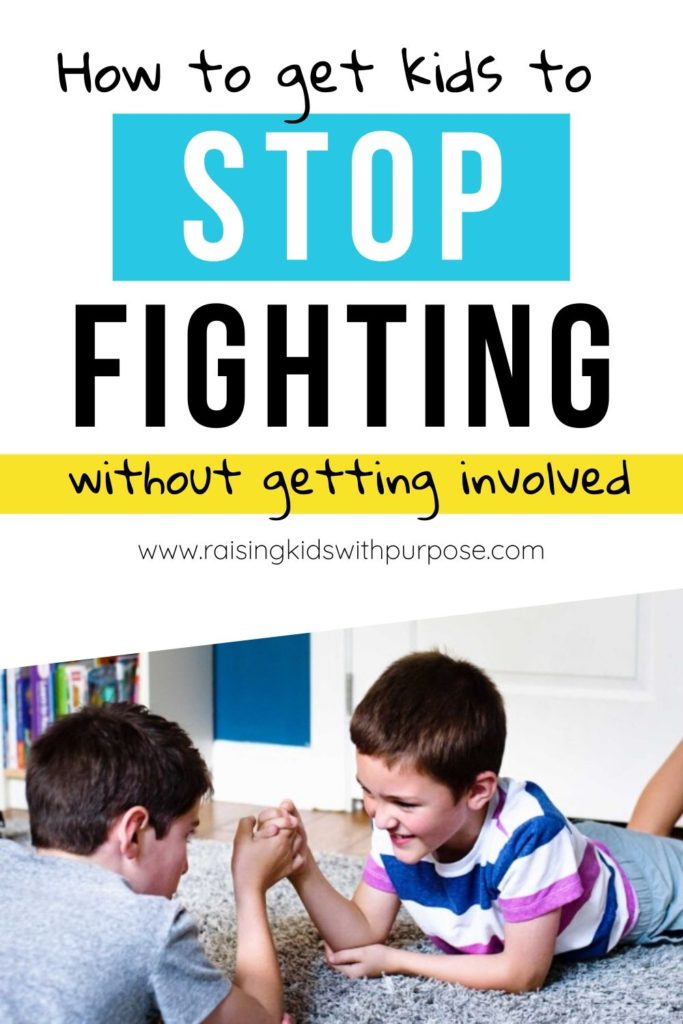
Table of Contents
The Reasons Siblings Fight
I break down the reasons siblings fight in this post. Basically, a lot is at play when it comes to brothers and sisters not being able to get along. Here are some of the main reasons:
- Development and maturity
- Sensory challenges
- Self-regulation skills
- Personality conflicts
- What is being modeled by peers, adults in their lives or other influences such as TV
- Culture
- Competition

It is good to look at the why behind any behavior so you know what to target in order for a change to happen. For my older boys, self-regulation and major sensory challenges and maturity all play a role in their sibling conflicts. One is incredibly impulsive and the other is highly sensitive so fighting can’t always be avoided.
The Key to Stop Siblings Fighting
My natural instinct when approaching a sibling quarrel is to correct, maybe increase the volume of my voice, use a strict tone and try to get them to stop immediately.
Or simply yell, “STOP FIGHTING!” or “BE NICE!”
However, this isn’t very effective. Womp Womp.
The reason is that if we take into account all the reasons why they might be fighting, being nice may not do the trick or they may not be able to stop due to how their brains are wired.
Instead, the key to eliminating siblings fighting is to teach your kids how to manage their own conflict.
On their own.
Without your involvement.
So really, this isn’t about keeping your kids from fighting but rather teach them how to resolve the conflicts they’re bound to have.
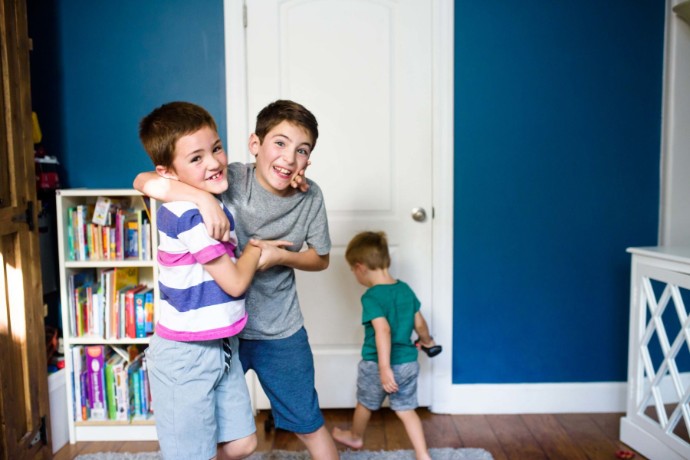
I recently read this quote from Corinna Tucker, a professor at the University of New Hampshire, “The sibling relationship is where you learn how to fight.”
Oooh, that’s good!
As kids grow into teens and then into adults, they will face conflict with friends, family, teachers, coaches, co-workers, or bosses. Where they get the best practice to resolve conflicts is with their own brothers and sisters under your roof!
Become Your Children’s COACH
Kids need to be taught how to resolve their own fighting. The best way to do this is to mediate the situation.
This does not mean you tell your kids what to say such as, “Tell him sorry,” or “Give back her toy,” but instead, guide the siblings into coming up with their own solution to the problem.
Remember, this is their problem, not yours!
What does this look like in the real world?
I’ve broken down what parenting experts recommend in teaching kids very important life skills such as conflict management, empathy, and perspective-taking.
Fighting Rules
You want to make sure you set ground rules ahead of time. Include your kids in deciding what these rules should be at your next family meeting.
There is a good chance they won’t follow all of these rules all of the time, but they’re good to have so your kids know what to strive for and what is important to your family.
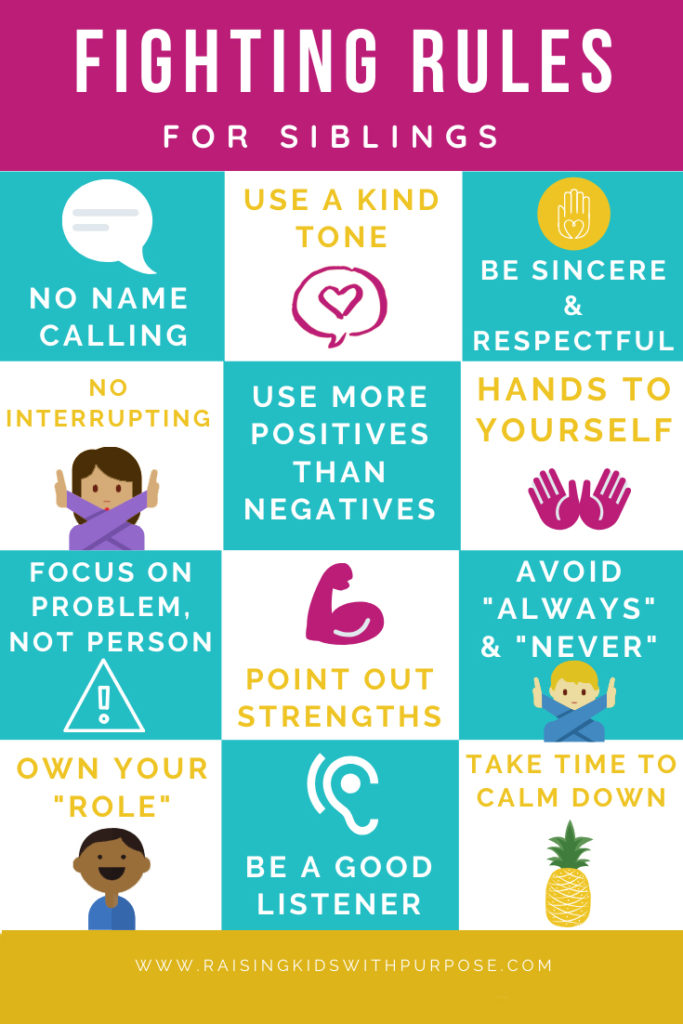
Pssst: You can snag this as a poster along with the “Our Family’s Fighting Rules” Poster when you sign up for my newsletter.
Calm Down Time
If the situation is already heated, there is zero reason to focus on getting your kids to work out a problem.
They can’t.
In order to think rationally, kids need to first be connected to the thinker part of the brain, the prefrontal cortex. This shuts down and is inaccessible when the brain perceives a threat. It goes into fight or flight and angry, frustrated, or super sad states.
In our house, the first step is to separate.
For some reason though, this is very difficult for our boys to do. Although they’ll be mad at each other, they can not physically get away. As a parent, it’s so frustrating. What we have been focusing on is getting them to be self-motivated to leave each other alone to cool off.
Read next: How to Define and Discover Your Family Values
Talk It Out
If your kids are younger, they may need your help in mediating who talks first. Allow each child to tell his or her side of the story and make sure the sibling actually listens.
As your kids get older, they need to learn how to do this on their own while following the fighting rules. It’s very hard to listen when someone is shouting or touching you.
Talking it out is much easier for siblings to do if they are given tools on how to communicate.
We have adopted “A Bug and a Wish” and “I feel when statements.” This makes it easy for each of our boys to express his or her feelings using words, not hands. In turn, it helps the child receiving the message understand how his or her actions are affecting others.
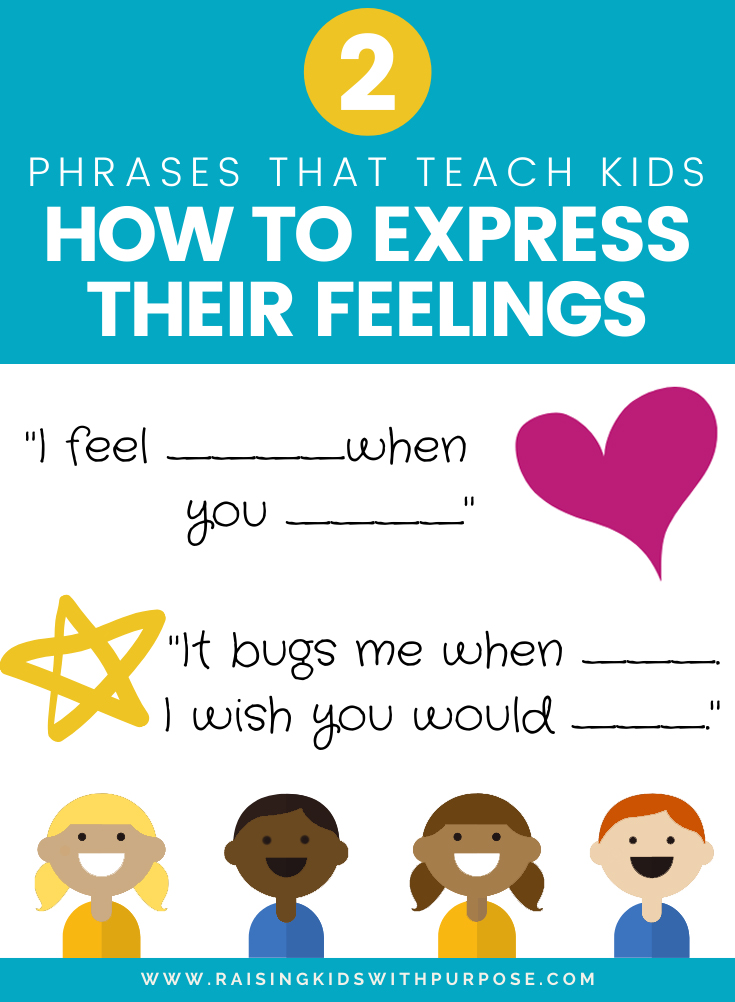
Perspective Taking
This is a big part in resolving conflicts. Kids are self-centered thanks to the under-development of the dorsolateral prefrontal cortex. They don’t have the developmental skills to understand or interpret how their actions affect another; especially a sibling. Therefore, they need to be taught.
A great way to do this is to ask questions! “How did your actions make your little sister feel?” or “Do you notice how he is feeling right now after you pinched his arm?”
Allow your child to do the thinking with your guidance!
>>Bonus Tip!
I read a research study about how siblings fighting can lead to poor mental health to my 10-year-old and immediately, I could see that he had an “uh oh” feeling in his gut. I wasn’t using this information to make him feel shame but rather, a little guilt. It helped him understand that his actions can make a lasting impact on others – for better or for worse.
Since sharing that information, his perspective has shifted a little causing him to put a lot more effort into resolving conflicts with his brother in a non-physical way. It has really brought them closer together…for the time being.
Solution Time
Typically, by the time our kids talk it out, they’re already onto the next thing. However, some conflicts need solutions. The reason is for both parties to move on so that conflict doesn’t happen again in the near future.
This can be done in any fashion that works best for your family. Every child is unique and handles stress differently. Siblings can write ideas that would work for both kids, draw pictures, or simply both come up with an idea and decide on which one would work best.
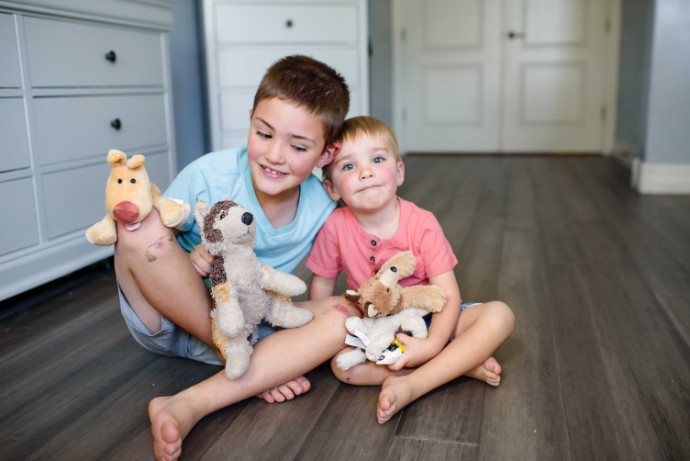
Act of Kindness
One last thing we do if the “offense” is bad is to encourage the offender to do an act of kindness for the brother or sister. Another phrase we often use is, “What can you do to make things right.” We also ask, “How do you think he or she is feeling?” This is instead of forcing a child to say, “sorry.”
A great way to do this is to have your kids fill out these kindness cards by For Purpose Kids! Or another suggestion could be to do chores for each other or play a preferred game.

Your Role in Ending Sibling Fighting
All of the above steps help kids resolve their own conflicts. When teaching these skills to your kids, it’s important that you:
- Let your kids work out the problems on their own
- Only intervene if it’s getting physical or harmful
- Do not take sides
- Model good conflict management yourself
- Have patience
Walk, Talk, or Rock
Now back to walk, talk, or rock. After understanding what needs to happen to help kids solve their own conflicts and fight less, this strategy is brilliant!
This simple parenting tool incorporates basic conflict management skills for kids in a playful way that gives your kids control.
When introducing the concept go through what each of the words means:
Walk – Either party can choose to walk AWAY. As I mentioned, our boys have a very tough time with this one. But for some reason, if it’s an option in this context, they are more likely to do it.
Talk – Together, your kids can choose to use their words (not hands) to solve the problem. Give them different ways to talk as mentioned above.
Rock – If the argument is over a toy that one person wants or an activity he or she wants to do, the siblings can do, “rock, paper, scissors” to see who gets it. This could cause more issues but usually, it’s a quick solution.
As I was writing this, I overheard my seven-year-old doing rock, paper, scissors with my toddler. My little guy didn’t really get it and just got angrier. So maybe, this strategy is better for kids who are a tad older!
Ending Siblings Fighting
Next time your kids are ready to battle it out, instead of running to the rescue and solving their problem or telling them what to do, let them work it out. And if they don’t have the tools yet, start loading up that toolbox!
Bonus! Fighting Rules!
For you! When you sign up for my newsletter, you will get a PDF you can download with two different fighting rules posters to hang and use as a reminder for your kids.
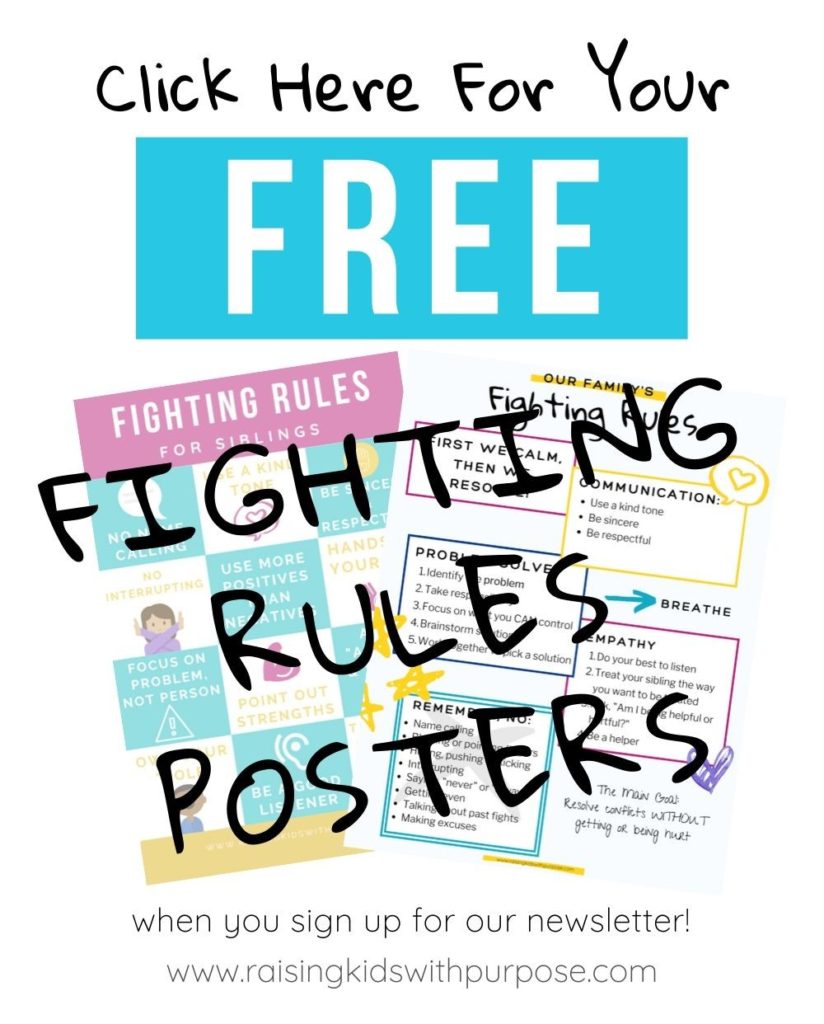
How do you handle sibling conflict?
Comment below and let me know what kind of tricks, tips, or strategies you employ when there is constant fighting in your house!

Hello!!! I’m Adriane. I’m a mom to three loud boys, am a research-a-holic and very passionate person who writes at Raising Kids With Purpose. Parenting can feel so hard sometimes but with mindset shifts and understanding, it can be very enjoyable. My hope is to inspire parents like you to create lifelong connections with your children and enjoy the journey along the way!


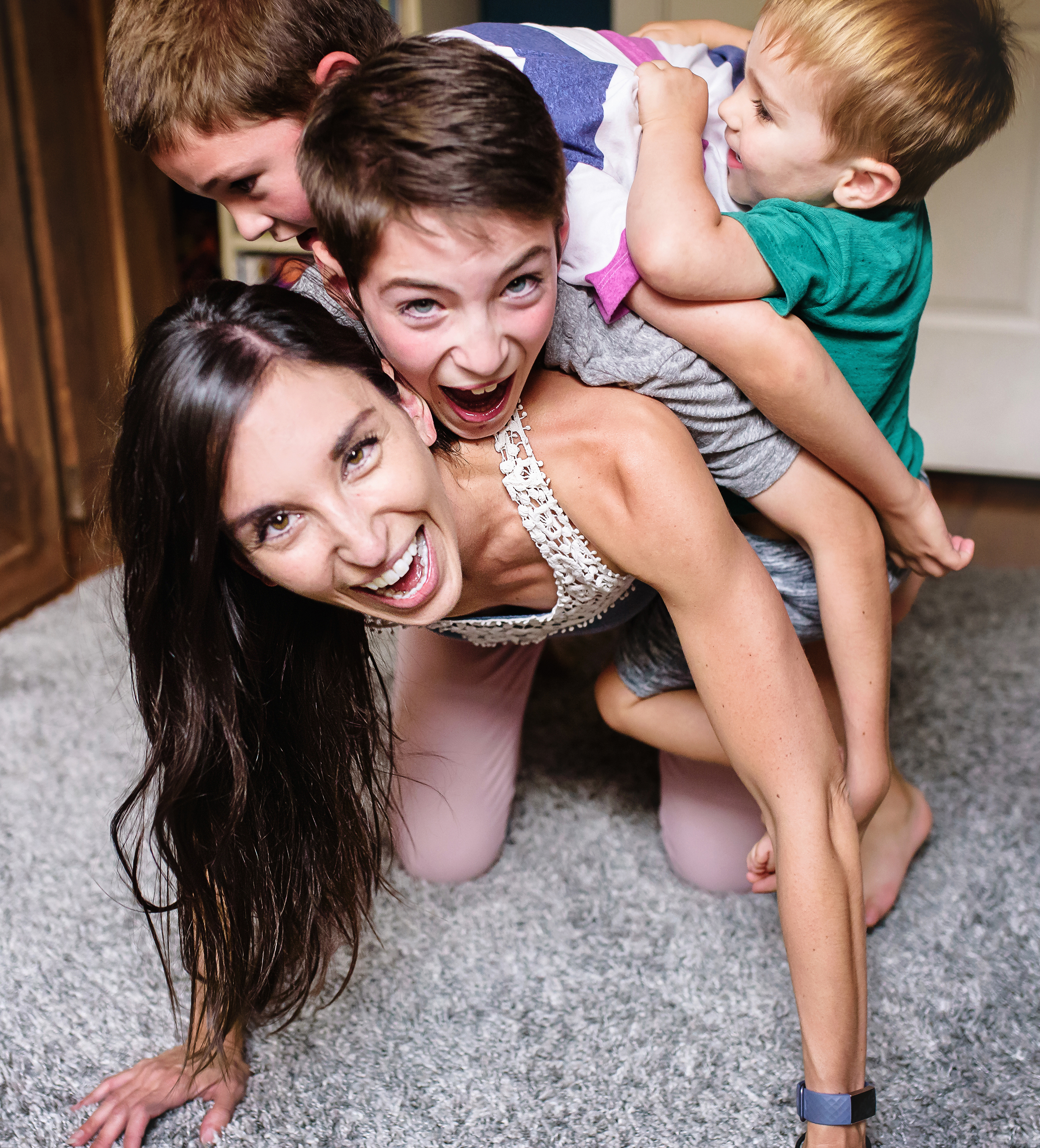
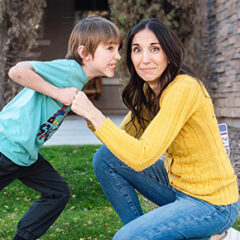
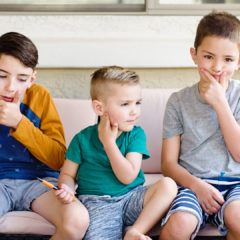


Marifer says
My 11 year old son and 7 year old daughter fight all the time. I come from an abusive family so I do not have good examples on how to react during this situations. All I know is that I hate it. I don’t want to scream at them or call them horrible names like my mom used to do to me. This article is giving me lots to work with. Thanks!
Adriane (Raising Kids With Purpose) says
Awe that hurts my heart you grew up in that kind of environment. Screaming does nothing and is extremely unhelpful. If I ever feel myself getting to that point, I whisper those exact words to myself “Yelling is unhelpful.” You have the power to break the generational cycle of that abuse and even yelling/screaming. Thank you for sharing and I’m happy this can help!
Kinzy says
These are great tips. I will save for when I have older children 🙂 Thanks for sharing!
Adriane (Raising Kids With Purpose) says
Of course!
Adriane (Raising Kids With Purpose) says
You’re welcome!
Dana Schlies says
This is so timely and your fighting rules are so helpful. With a house of 4 little kids, we have lots of arguing! I’ll be printing your rules to hang in our school room. Thank you for the helpful tips!
Adriane (Raising Kids With Purpose) says
Oh I’m sure! At least they have each other during this time. I hope the rules help!
Adriane (Raising Kids With Purpose) says
I”m sure! At least they have each other during this time though. Thank you!!
Yana says
These are great tips. I will definitely need to imply these more on my kids. I believe that they grow as they learn to manage their conflicts.
Adriane (Raising Kids With Purpose) says
Yes, they sure do grow and learn!
Faith @ForMommiesByMommy says
These parenting tips are really wise and helpful! I’ve got three kids and sibling fights are really common in our home! Thanks for yo ur advice!
Adriane (Raising Kids With Purpose) says
Thank you so much! They’re learning so many new skills when the fight!
Starr says
This is such a great post!! I have never heard of the “Walk, Talk, or Rock” concept, but it’s brilliant! The kindsness cards are a great idea as well! When my daughters argue, I have them say 5 things that they like about the other one.
Thanks again, your posts are always so helpful!
Adriane (Raising Kids With Purpose) says
Awe, thank you so much, Starr! I hadn’t either and also thought it was brilliant! It keeps the ball in their court and helps kids learn valuable life skills! I love how you have your girls give positive affirmations to each other! We try that sometimes but it doesn’t always go so well. Not sure if it’s because they’re boys or just because they rather call each other names. LOL! Thank you!
Kimberlie says
I currently only have one child, but the resources in this post will be so helpful to parents with multiple children in the house. I can even adapt them for use in my classroom, when schools are back in session.
Adriane (Raising Kids With Purpose) says
Absolutely! Conflict management in the classroom is huge!
Kam says
I had no idea about “Walk, Talk or Rock” but as you explained it towards the end, it made sense, lot of sense. Wish there were such things when we were growing up. These are some amazing tips for parents with two ore more kids, These also help kids with conflict solving in the long run. Thanks for sharing!
Adriane (Raising Kids With Purpose) says
I know, right? We just know so much more about brain development and psychological health! I’m super thankful for all the researchers and experts out there!!! And you are very welcome 🙂
Stephanie says
These are great tips! I try to help my kids understand why fighting isn’t good and to compromise.
Adriane (Raising Kids With Purpose) says
compromise is a good idea!
Desiree at Fitmomology says
I love “Walk, Talk or Rock”! How awesome of an idea! I’ve only got one kiddo but I will forward this to friends with multiple children!
Adriane (Raising Kids With Purpose) says
Yes! It works GREAT!!! It gets my kids to work out their own problems as long as they do it before it gets physical. #boys!
Tamara Monoskie says
I have already implemented A Bug & A Wish from your previous post, so Walk, Talk, Rock is a natural logical next right thing! Thanks for sharing. I told my DV therapist about A Bug & a Wish last month and she liked it so much that she asked if she could share it with her other DV clients. We do the birthday candle blowouts (inhale and exhale in several sort bursts), when the screams and tattling start. Now I know to use the W, T, R after they are calm enough to be coherent. Great stuff, Adriane, You’re a Godsend.
Adriane (Raising Kids With Purpose) says
Awe this is the sweetest comment ever! I’m so happy it’s helping. And thanks for sharing!! Yes, when I heard the rock, talk and walk, I knew I had to share it with others. It’s such a great tool. Thank you for all your love and support <3
Melinda Cummings says
I’m going to add your printable to our family binder!
It’s hard with an almost 12 year old and a newly 5 year old … and being on week 6 of lock down.
I think it’s their maturity levels mostly.
We try to encourage our kids to figure things out amongst themselves as well.
It helps if we can catch them and coach them before it escalates.
They’re both so passionate and will hold their ground.